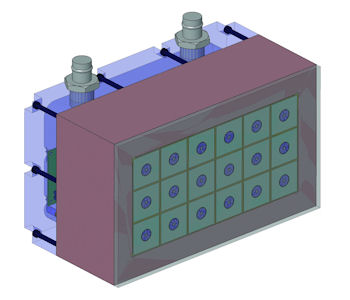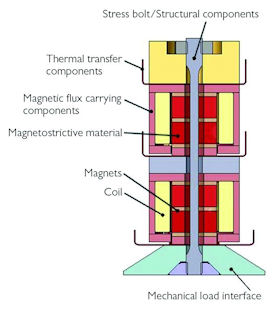
Figure 3: Closely packed SONAR array, which includes a magnetostrictive transducer at its core (far left), which is packaged with power electronics (left). The full array (above), is made up of 18 transducer elements.
Latest News
July 1, 2014
- Figure 1: Magnetostrictive materials change their physical shape in response to an applied magnetic field and vice versa.
Materials that demonstrate different responses to varying external stimuli are known as “smart materials,” and their discovery has led to the creation of products that perform on a whole new level. These engineered materials are developed to perform smarter and more efficiently than their predecessors, allowing materials to be designed based on the products and environments in which they will be used. Magnetostrictive materials are engineered smart materials that change shape when exposed to a magnetic field and they have proven crucial for the production of transducers, sensors and other high-powered electrical devices.
Engineers at ETREMA Products Inc. design devices using magnetostrictive materials for defense and other industry applications including sensors, loudspeakers, actuators, SONAR and energy harvesting devices. The unique properties of magnetostrictive materials — such as their ability to mechanically respond to magnetic fields and their characteristic nonlinearity — make designing these devices a challenge.
Researchers at ETREMA have found that multiphysics simulation can be used to accurately represent the material properties and complex physics interactions within such devices, facilitating the production of the next generation of smart products.
Design and Simulation of Magnetostrictive Transducers
Magnetostriction occurs at the magnetic domain level as magnetic regions realign in response to variation in either magnetic or mechanical energy, causing a change in a material’s shape or magnetic state (see Fig. 1).
 Figure 2: Diagram of a magnetostrictive transducer showing the magnetic and mechanical components of the device.
Figure 2: Diagram of a magnetostrictive transducer showing the magnetic and mechanical components of the device.For example, the magnetostrictive material iron elongates by 0.002 percent when exposed to a strong magnetic field, and nickel contracts by 0.007 percent under that same field. Terfenol-D, a “giant magnetostrictive material,” demonstrates deformations 100 times that of iron and was first developed by the U.S. Navy in the 1970s. ETREMA is currently its sole commercial producer.
ETREMA designs magnetostrictive transducers (see Fig. 2) using Terfenol-D — devices that convert magnetic energy into mechanical energy and are critical components of many larger, more complex systems. To accurately model these complex devices, ETREMA uses COMSOL Multiphysics. Their simulations include permanent magnets and coils, the magnetic fields created by these coils, stress and modal analyses of structural mechanics components, as well as heat transfer in the device to mitigate heat generated by eddy currents and hysteresis. Fully coupled models are used to evaluate the overall electro-mechanical characteristics of these transducers.
“When we first began to expand our engineering process to model such devices, our modeling techniques consisted of a system of disjointed methods that included hand calculations, equivalent circuits, and single-physics modeling,” says Julie Slaughter, senior engineer at ETREMA. “However, our decision to move toward a devices and systems approach coincided with the advent of multiphysics finite element analysis and we adopted COMSOL as our modeling tool for systems-based modeling. This greatly improved our understanding of transducers and their design.”
ETREMA’s modeling approach demonstrates the unique flexibility of COMSOL Multiphysics. First, models are created to analyze individual physics; then, multiphysics simulations are built to determine how the physics interact with one another. This approach allows for both a targeted look as well as a complete picture of the physics interactions taking place.
Design Diagnosis
An overview of this design process can be seen in the design of a close-packed SONAR source array, which includes a magnetostrictive transducer at its core (see Fig. 3). Not only are there many different material properties that need analysis and optimization, but the transducer also contains a combination of electrical, magnetic and structural physics that interact within the device.
[gallery ids=”/article/wp-content/uploads/2014/07/fig_3a_300.jpg|,/article/wp-content/uploads/2014/07/fig_3b_300.jpg|,/article/wp-content/uploads/2014/07/fig_3d_300.jpg|Figure 3: Closely packed SONAR array, which includes a magnetostrictive transducer at its core (far left), which is packaged with power electronics (left). The full array (above), is made up of 18 transducer elements.”]
Deformation within the transducer was analyzed using a single-physics model in which static loads were used to estimate fatigue and determine if the prestressed bolts and Terfenol-D core would hold up against the system’s strain. The initial transducer design demonstrated severe bending at the mechanical interface between the transducer and the load. However, further load analysis and structural optimizations allowed the transducer to be redesigned with reduced deformation and stress (see Fig. 4). The model was also used to detect undesirable modes of vibration in the operating bandwidth that could affect overall performance.
[gallery columns=“2” ids=”/article/wp-content/uploads/2014/07/fig_4a_225.jpg|Figure 4: The initial transducer design shows severe bending in the mechanical interface to the load. ,/article/wp-content/uploads/2014/07/fig_4b_225.jpg|The redesigned model demonstrates reduced deformation.”]
Single-physics models were developed to evaluate the DC and AC magnetics separately. “We matched the electrical requirements of the transducer with the available power amplifiers, and evaluated electrical losses due to eddy currents and air gaps within the device,” says Slaughter. Permanent magnets were integrated into the transducer design to magnetically bias the material and enable bidirectional motion and minimize nonlinear behavior and frequency-doubling effects. “Stray magnetic fields in close proximity with the electronics can cause problems with noise and corrupted signals,” Slaughter explains. “We had to carefully consider the design of the transducer’s magnetic circuit as well as the placement of key electrical components to avoid stray magnetic flux that can interfere with the electronics.”
Using COMSOL, ETREMA researchers were able to find an optimal design for the competing requirements of both the AC and DC magnetics. The design’s models demonstrated that the magnetic fields mainly stay confined to the magnetic components, thereby reducing the exposure of the electronics to the magnetic fields.
Design Validation
The next step in ETREMA’s design process was to create fully coupled multiphysics models. “When setting up our multiphysics models, we use coupled equations, where strain is a function of stress and also of the magnetic field,” says Slaughter. “This is the basis of implementing coupled magnetostriction in COMSOL.” Using this process, Slaughter and her team determined how the magnetic and mechanical domains would interact within the device and predicted how the magnetostrictive material’s behavior. (see Fig. 5).
[gallery columns=“2” ids=”/article/wp-content/uploads/2014/07/fig_5a_620.jpg|Figure 5: Magnetic fields generated from a 1-ampere input to the coil. Displacements are calculated using the maximum current input.,/article/wp-content/uploads/2014/07/fig_5b_445.jpg|”]
“For the coupled linear magnetostrictive model, our simulations showed that the device would perform largely as expected, with few adjustments needed in either the mechanical or magnetic aspects of the design,” she continues. “The magnetic fields remained confined to the magnetic circuit, and deformations remained minimal.”
These multiphysics models were further validated using experimental data. “The models of impedance and displacement were very similar to experimental results,” says Slaughter.
A Multiphysics Approach to Modeling
At ETREMA, both single-physics models and fully coupled multiphysics simulations have proven to be powerful tools for transducer design, evaluation and optimization. The construction of single-physics models allows for design diagnosis prior to the development of multiphysics models, where attributing an undesired interaction to a certain physics type is more straightforward. Coupled models then further describe the way the individual physics will interact in the real world.
Although ETREMA focuses on magnetostrictive materials, all transducer technologies involve coupled multiphysics interactions, including piezoelectric, electrostatic and electromagnetic effects, and each can benefit from the use of multiphysics simulations. Finite element models can be used at different stages of product development — during design development, for the evaluation of existing products, and when it is necessary to troubleshoot performance issues.
Alexandra Foley wrote this article on behalf of COMSOL.
Subscribe to our FREE magazine, FREE email newsletters or both!
Latest News








